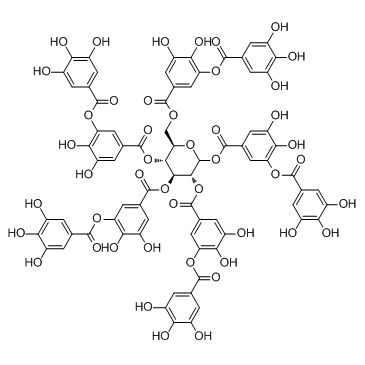
Glycerite
CAS No. 1401-55-4
Glycerite( Tannic acid | NSC 656273 | NSC-656273 )
Catalog No. M11675 CAS No. 1401-55-4
Polyphenolic compounds with molecular weights of around 500-3000 daltons and containing enough hydroxyl groups (1-2 per 100 MW) for effective cross linking of other compounds (ASTRINGENTS).
Purity : >98% (HPLC)
 COA
COA
 Datasheet
Datasheet
 HNMR
HNMR
 HPLC
HPLC
 MSDS
MSDS
 Handing Instructions
Handing Instructions
| Size | Price / USD | Stock | Quantity |
| 500MG | 37 | In Stock |


|
| 1G | Get Quote | In Stock |


|
Biological Information
-
Product NameGlycerite
-
NoteResearch use only, not for human use.
-
Brief DescriptionPolyphenolic compounds with molecular weights of around 500-3000 daltons and containing enough hydroxyl groups (1-2 per 100 MW) for effective cross linking of other compounds (ASTRINGENTS).
-
DescriptionPolyphenolic compounds with molecular weights of around 500-3000 daltons and containing enough hydroxyl groups (1-2 per 100 MW) for effective cross linking of other compounds (ASTRINGENTS). The two main types are HYDROLYZABLE TANNINS and CONDENSED TANNINS. Historically, the term has applied to many compounds and plant extracts able to render skin COLLAGEN impervious to degradation. The word tannin derives from the Celtic word for OAK TREE which was used for leather processing. (In Vivo):During the course of treatment, tannic acid significantly ameliorates these phenotypes in AD skin lesions. Tannic acid treatment aslo reduces these dermal changes compare with AD mice. Treatment with tannic acid increases PPARγ expression in AD skin sections. The PPARγ protein expression is suppressed in vehicle-treated AD mice, but when treats with tannic acid, its expression is increased dramatically. The IL-1β, TNFα, TNFR1, and COX2 protein expressions are significantly up-regulated in vehicle-treated AD mice, but significantly suppressed by tannic acid treatment.
-
In Vitro——
-
In VivoDuring the course of treatment, tannic acid significantly ameliorates these phenotypes in AD skin lesions. Tannic acid treatment aslo reduces these dermal changes compare with AD mice. Treatment with tannic acid increases PPARγ expression in AD skin sections. The PPARγ protein expression is suppressed in vehicle-treated AD mice, but when treats with tannic acid, its expression is increased dramatically. The IL-1β, TNFα, TNFR1, and COX2 protein expressions are significantly up-regulated in vehicle-treated AD mice, but significantly suppressed by tannic acid treatment.
-
SynonymsTannic acid | NSC 656273 | NSC-656273
-
PathwayOthers
-
TargetOther Targets
-
RecptorOthers
-
Research Area——
-
Indication——
Chemical Information
-
CAS Number1401-55-4
-
Formula Weight1701.2
-
Molecular FormulaC76H52O46
-
Purity>98% (HPLC)
-
SolubilityDMSO: 10 mM
-
SMILESOC1=C(O)C(O)=CC(C(OC2=CC(C(OCC3C(OC(C4=CC(O)=C(O)C(OC(C5=CC(O)=C(O)C(O)=C5)=O)=C4)=O)C(OC(C6=CC(O)=C(O)C(OC(C7=CC(O)=C(O)C(O)=C7)=O)=C6)=O)C(OC(C8=CC(O)=C(O)C(OC(C9=CC(O)=C(O)C(O)=C9)=O)=C8)=O)C(OC(C%10=CC(O)=C(O)C(OC(C%11=CC(O)=C(O)C(O)=C%11)=O)=C%10)=O)O3)=O)=CC(O)=C2O)=O)=C1
-
Chemical Name6-(((3,4-dihydroxy-5-((3,4,5-trihydroxybenzoyl)oxy)benzoyl)oxy)methyl)tetrahydro-2H-pyran-2,3,4,5-tetrayl tetrakis(3,4-dihydroxy-5-((3,4,5-trihydroxybenzoyl)oxy)benzoate)
Shipping & Storage Information
-
Storage(-20℃)
-
ShippingWith Ice Pack
-
Stability≥ 2 years
Reference
1.JENKINS JT. Am J Surg. 1947 Oct;74(4):428-30.
molnova catalog



related products
-
Mepacrine
Mepacrine (Erion) is an acridine derivative formerly widely used as an antimalarial. It is used in cell biological experiments as an inhibitor of phospholipase A2.
-
Lasiodonin
Lasiodonin is a natural product isolated from the leaves of Isodon parvifolius.
-
D-Fructose-13C6
D-Fructose-13C6 can be used as an internal standard for the quantification of D-fructose by GC- or LC-MS.



 Cart
Cart
 sales@molnova.com
sales@molnova.com


